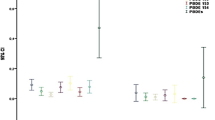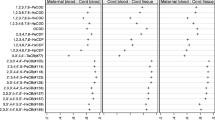Abstract
Introduction
Concentrations and congener profiles of polychlorinated biphenyls (PCBs) and their hydroxylated metabolites (OH-PCBs) in placenta samples from a Madrid population (Spain) are reported. Structure dependent retentions of OH-PCBs are known to occur in both humans and wildlife, making it of interest to assess placental transfer of both parent compounds and their metabolites to the developing foetus.
Results
The ΣPCB concentrations found in placenta samples were in the range 943–4,331 pg/g fresh weight (f.w.), and their hydroxylated metabolites showed a 20-time lower concentration level (53–261 pg/g f.w.). The PCB profiles were surprisingly dominated by CB-52 and CB-101 accounting for more than 44% of the total PCB concentration. This is indicating a source of exposure that is not yet identified. The OH-PCB profiles were dominated by 4-OH-CB187 and 4-OH-CB146, representing >50% of the ΣOH-PCB concentration of the placenta samples. Statistical analysis of the data revealed strong correlations between the PCB congeners, among some OH-PCBs, and between OH-PCB metabolites with a meta- and para- substitution pattern. Both PCB and OH-PCB concentrations presented homogeneous distribution, what allowed the establishment of a partial least squares model that correlated the concentrations of OH-PCB with those of PCBs in placenta samples. In addition, causal correlations were observed between the concentrations of OH-PCBs and those of their corresponding PCB precursors.




Similar content being viewed by others
References
Axmon A, Hagmar L, Jönsson BAG (2008) Rapid decline of persistent organochlorine pollutants in serum among young Swedish males. Chemosphere 70:1620–1628. doi:10.1016/j.chemosphere.2007.07.077
Bergman A, Klasson-Wehler E, Kuroki H, Nilsson A (1995) Synthesis and mass spectrometry of some methoxylated PCB. Chemosphere 30:1921–1938. doi:10.1016/0045-6535(95)00073-H
Boon JP, Eijgenraam F, Everaarts JM, Duinker JC (1989) A structure-activity relationship (SAR) approach towards metabolism of PCBs in marine mammals from different trophic levels. Mar Environ Res 27:159–176. doi:10.1016/0141-1136(89)90022-6
Braathen M, Mortensen AS, Sandvik M, Skåre JU, Arukwe A (2009) Estrogenic effects of selected hydroxy polychlorinated biphenyl congeners in primary culture of Atlantic salmon (Salmo salar) hepatocytes. Arch Environ Contam Toxicol 56:111–122. doi:10.1007/s00244-008-9163-0
Chan SY, Vasilopoulou E, Kilby MD (2009) The role of the placenta in thyroid hormone delivery to the fetus. Nat Clin Pract Endocrinol Metab 5:45–54. doi:10.1038/ncpendmet1026
Covaci A, Jorens P, Jacquemyn Y, Schepens R (2002) Distribution of PCBs and organochlorine pesticides in umbilical cord and maternal serum. Sci Total Environ 298:45–53. doi:10.1016/S0048-9697(02)00167-5
Gómara B, Herero L, Ramos JJ, Mateo JR, Fernández MA, García JF, González MJ (2007) Distribution of polybrominated diphenyl ethers in human umbilical cord serum, paternal serum, maternal serum, placentas, and breast milk from Madrid population, Spain. Environ Sci Technol 41:6961–6968. doi:10.1021/es0714484
Gutleb AC, Cenijn P, van Velzen M, Lie E, Ropstad E, Skaare JU, Malmberg T, Bergman A, Gabrielsen GW, Legler J (2010) In vitro assay shows that PCB metabolites completely saturate thyroid hormone transport capacity in blood of wild polar bears (Ursus maritimus). Environ Sci Technol 44:3149–3154. doi:10.1021/es903029j
Guvenius DM, Hassanzadeh P, Bergman A, Noren K (2002) Metabolites of polychlorinated biphenyls in human liver and adipose tissue. Environ Toxicol Chem 21:2264–2269
Guvenius DM, Aronsson A, Ekman-Ordeberg G, Bergman A, Noren K (2003) Human prenatal and postnatal exposure to polybrominated diphenyl ethers, polychlorinated biphenyls, polychlorobiphenylols, and pentachlorophenol. Environ Health Perspect 111:1235–1241. doi:10.1289/ehp.5946
Haraguchi K, Kato Y, Kimura R, Masuda Y (1998) Hydroxylation and methylthiolation of mono-ortho-substituted polychlorinated biphenyls in rats: identification of metabolites with tissue affinity. Chem Res Toxicol 11:1508–1515. doi:10.1021/tx980183r
Hovander L, Athanasiadou M, Asplund L, Jensen S, Klasson Wehler E (2000) Extraction and cleanup methods for analysis of phenolic and neutral organohalogens in plasma. J Anal Toxicol 24:696–703
Hovander L, Linderholm L, Athanasiadou M, Athanassiadis I, Bignert A, Fängström B, Kocan A, Petrik J, Trnovec T, Bergman A (2006) Levels of PCBs and their metabolites in the serum of residents of a highly contaminated area in eastern Slovakia. Environ Sci Technol 40:3696–3703. doi:10.1021/es0525657
Kawashiro Y, Fukata H, Omori-Inoue M, Kubonoya K, Jotaki T, Takigami H, Sakai S-I, Mori C (2008) Perinatal exposure to brominated flame retardants and polychlorinated biphenyls in Japan. Endocrine J 55:1071–1084. doi:10.1507/endocrj.K08E-155
Letcher RJ, Klasson WE, Bergman A (2000) Methylsulfon and hydroxylated metabolites of polychlorinated biphenyls. In: Paasivirta J (ed) Handbook of environmental chemistry, new types of persistent halogenated compounds. Springer, Berlin, pp 315–359
Linderholm L, Park J-S, Kocan A, Trnovec T, Athanasiadou M, Bergman A, Hertz-Picciotto I (2007) Maternal and cord serum exposure to PCB and DDE methyl sulfone metabolites in eastern Slovakia. Chemosphere 69:403–410. doi:10.1016/j.chemosphere.2007.04.081
McFarland VA, Clarke JU (1989) Environmental occurrence, abundance and potential toxicity of polychlorinated congeners: considerations for a congener specific analysis. Environ Health Perspect 81:225–239. doi:10.1016/S1001-0742(07)60055-2
Meerts IATM, Assink Y, Cenijn PH, van den Berg JHJ, Weijers BM, Bergman A, Koeman JH, Brouwer A (2002) Placental transfer of a hydroxylated polychlorinated biphenyl and effects on fetal and maternal thyroid hormone homeostasis in the rat. Toxicol Sci 68:361–371. doi:10.1093/toxsci/68.2.361
Mortensen AS, Braathen M, Sandvik M, Arukwe A (2007) Effects of hydroxy-polychlorinated biphenyl (OH-PCB) congeners on the xenobiotic biotransformation gene expression patterns in primary culture of Atlantic salmon (Salmo salar) hepatocytes. Ecotoxicol Environ Saf 68:351–360. doi:10.1016/j.ecoenv.2006.11.019
Myllynen P, Pasanen M, Pelkonen O (2005) Human placenta: a human organ for developmental toxicology research and biomonitoring. Placenta 26:361–371. doi:10.1016/j.placenta.2004.09.006
Ohta C, Haraguchi K, Kato Y, Endo T, Matsuoka M, Koga N (2008) Metabolism of 2,2′,3,4′,5,5′-hexachlorobiphenyl (CB146) by liver microsomes from rats, hamsters and guinea pigs. Organohalogen Compd 70:1185–1188
Park J-S, Linderholm L, Charles MJ, Athanasiadou M, Petrik J, Kocan A, Drobna B, Trnovec T, Bergman A, Hertz-Picciotto I (2007) Polychlorinated biphenyls and their hydroxylated metabolites (OH-PCBs) in pregnant women from Eastern Slovakia. Environ Health Perspect 115:20–27. doi:10.1289/ehp.8913
Park J-S, Bergman A, Linderholm L, Athanasiadou M, Kocan A, Petrik J, Drobna B, Trnovec T, Charles MJ, Hertz-Picciotto I (2008) Placental transfer of polychlorinated biphenyls, their hydroxylated metabolites and pentachlorophenol in pregnant women from eastern Slovakia. Chemosphere 70:1676–1684. doi:10.1016/j.chemosphere.2007.07.049
Sandau CD (2000) Analytical chemistry of hydroxylated metabolites of PCBs and other halogenated phenolic compounds in blood and their relationship to thyroid hormone and retinol homeostasis in humans and polar bears. Ph.D. dissertation, Carleton University, Ottawa, Ontario. pp 39–44
Sandau CD, Ayotte P, Dewailly E, Duffe J, Norstrom RJ (2000) Analysis of hydroxylated metabolites of PCBs (OH-PCBs) and other chlorinated phenolic compounds in whole blood from Canadian Inuit. Environ Health Perspect 108:611–616. doi:10.2307/3434880
Schecter A, Kassis I, Papke O (1998) Partitioning of dioxins, dibenzofurans, and coplanar PCBs in blood, milk, adipose tissue, placenta and cord blood from five American women. Chemosphere 37:1817–1823. doi:10.1016/S0045-6535(98)00247-1
Soechitram SD, Athanasiadou M, Hovander L, Bergman A, Sauer PJJ (2004) Fetal exposure to PCBs and their hydroxylated metabolites in a Dutch cohort. Environ Health Perspect 112:1208–1212. doi:10.1289/ehp.6424
Wang S-L, Lin C-Y, Guo Y-L, Lin L-Y, Chou W-L, Chang L-W (2004) Infant exposure to polychlorinated dibenzo-p-dioxins, dibenzofurans and biphenyls (PCDD/Fs, PCBs) - correlation between prenatal and postnatal exposure. Chemosphere 54:1459–1473. doi:10.1016/j.chemosphere.2003.08.012
Weijs L, Das K, Siebert U, Neels H, Blust R, Covaci A (2008) PCBs, PBDEs and their hydroxylated metabolites in serum of free-ranging harbour seals (Phoca vitulina): levels and profiles. Organohalogen Compd 70:837–840
Acknowledgements
The authors thank the Biomarker Group of CM for supplying the samples. B. Gómara wishes to thank the CSIC-I3P programme for her postdoctoral grant and J. Fång for his kind help. Financial support was provided by projects CSIC (200880I192), CM (P2009/AGR-1464) and MICINN (AGL2009-09733).
Author information
Authors and Affiliations
Corresponding author
Additional information
Responsible editor: Philippe Garrigues
Rights and permissions
About this article
Cite this article
Gómara, B., Athanasiadou, M., Quintanilla-López, J.E. et al. Polychlorinated biphenyls and their hydroxylated metabolites in placenta from Madrid mothers. Environ Sci Pollut Res 19, 139–147 (2012). https://doi.org/10.1007/s11356-011-0545-x
Received:
Accepted:
Published:
Issue Date:
DOI: https://doi.org/10.1007/s11356-011-0545-x




